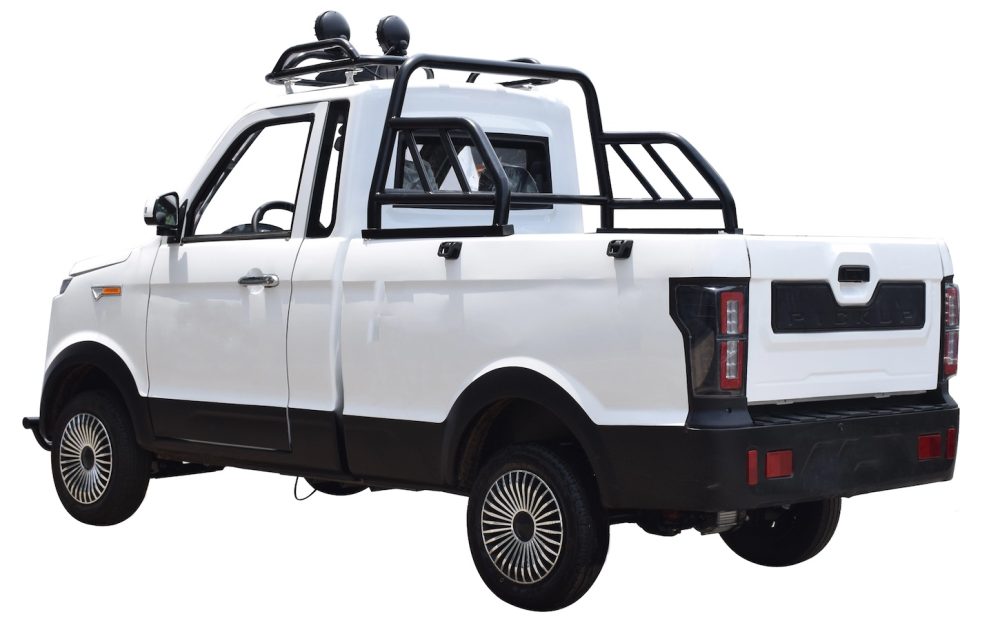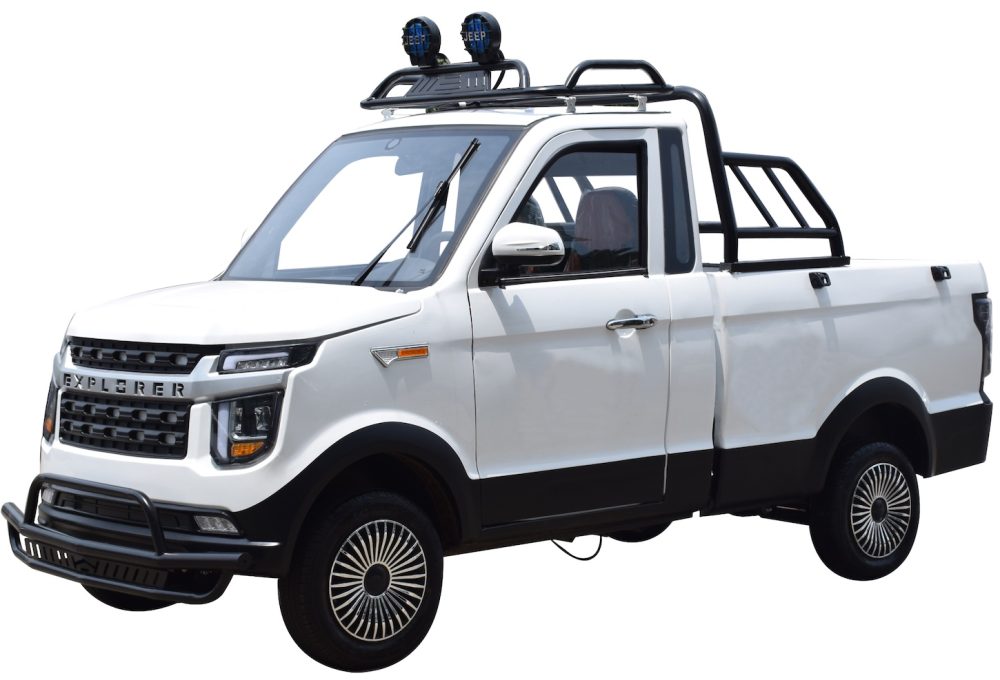
If you’re anything like me, you watched the unveiling of the Tesla Cybertruck and the electric Ford F-150 Lightning truck and thought, “Damn, those are pretty cool, but I probably shouldn’t drop $40,000-$50,000 on an electric truck that I don’t really need.”
However, despite realizing I couldn’t justify an expensive electric truck, I never gave up the dream of joyriding in one and tossing all sorts of weird stuff in the back, which is probably why when the chance finally arose, I made the impulse buy of a much, MUCH more affordable (albeit smaller) electric pickup truck straight from China.
First, a little background.
I’m fairly familiar with using Chinese light electric vehicles. I have several electric bicycles and mopeds, almost all of which are made – well – in China.
I also write a weekly column where I feature awesome and weird electric vehicles that I found on Alibaba.
A couple weeks ago, I stumbled upon a cool little electric pickup truck from a factory called ChangLi and instantly fell in love with it. The thing is only 10 feet long and tops out at 25 mph, but I love it all the same.
It’s got Neighborhood Electric Vehicle (NEV) specs and is designed for light-duty work. However, it’s also a fully fledged truck, even if it’s a small one. It’s enclosed, has real seats and seatbelts, electric windows, a backup camera, and even a hydraulic dumping bed. It’s a pretty legit little electric truck.
The cherry on top was that it was only $2,000! Or at least I thought it was at first.
Of course, nothing on the internet is ever as it seems, even tiny electric trucks. The $2,000 price was legit, but that didn’t include batteries. It was another $300 or so for heavy lead acid batteries, $500 if I wanted a lithium-ion battery pack (3 kWh), $710 for a bigger lithium pack (5 kWh), and $1,050 if I wanted a giant lithium battery (6 kWh).
I sprung for the giant battery. Screw it — in for a penny, in for a pound.
Next came my add-ons. I’m planning on using this thing in Florida, so air conditioning is going to keep them from having to peel me off those seats with a spatula. $230 right there.
Next was the hydraulic dumping bed. I don’t need it, but I wanted it. $228. Done. Next?
Whoa, hold up. Pump the brakes, kid. What’s the total now? $3,500-ish. Alright, that will probably do me. This is an impulse buy, after all.
Next came sea freight. This is a small truck, but it still takes up a sizeable chunk of a container. Doing LCL (less than container load) shipping means I’ll share a container with others and just pay my share — but my share turned out to be $2,210. Ouch.
A year ago, that would have been a quarter of the price, but them’s the times, and shipping isn’t cheap anymore.
The price was walking its way up, but throughout all of this, my excitement kept me going.
And so has the factory, which has been super chill about showing me my truck as it gets tested and then packaged. I started communicating with them using the Alibaba chat function but soon moved to WhatsApp for easier and more convenient chatting.
They even video chatted with me while driving the truck around to show me how it worked. That’s my truck!

So all told, I’m approaching $6,000. It’s starting to get a bit crazy for an impulse buy. But, then again, it’s also crazy that you can buy a full vehicle — I’m talking four wheels, suspension, lighting, metal body, hydraulic dumper, and a freaking infotainment system — shipped halfway around the world for just $6,000.
Or perhaps $1,000 less if you didn’t get the ridiculously oversized battery and hydraulic dumper.
And the truly amazing thing is, that’s still less expensive than the cost of a new golf cart, which can often run in the $7,000-$9,000 range.
Plus, I haven’t seen many golf carts with air conditioning or electric windows (or any windows, for that matter).
This is also the part where I start deluding myself into thinking that it’s only $6,000, though.
Keep in mind that I still haven’t paid my customs broker, who will have to handle all the customs forms and clearances for me, so I don’t have to take night classes to earn a major in international import law.
And I still haven’t paid a truck driver to truck it the last 50 miles from port to my home.
Now, I’ve got several weeks of waiting until the truck shows up in port, and I can begin that nightmare next step.

So the point is, I’ve got an awesome electric truck coming, though it’s been a long few weeks of back-and-forth communication with the factory, with my customs broker, and with DOT/NHTSA/EPA regulations pamphlets to even figure out how this whole thing is going to work.
Fortunately, there’s actually a better way. And ironically, I found out about it a few days after I placed the order for my truck.
Out in Utah, there’s a little outfit known as Electric Import Motors (EIM), and they do this exact same thing on a larger scale so that people like me don’t have to jump through all these hoops to get a fun and functional mini electric vehicle from China.
Owner Caleb Nelson started last year by bringing in one of ChangLi’s small four-seater electric cars. That led to a container of them, which led to more containers and then a container of — you guessed it — my ChangLi truck!
Caleb was so fascinated by the little EVs and thought that Americans could make use of them, just like so many people in Asia do, that he committed to providing an alternative to private imports.
EIM deals with the hassle of importing and clearing customs for these little cars, so Americans can simply order one as easily as they can order an electric bicycle. A few clicks and a mini car or truck shows up at your driveway. The car version, which has a smaller battery and lower power motor, starts at $4,800, while the truck starts at closer to $7,500. Adding options increases the price (and my fully outfitted truck would likely be north of $9,000), but those options allow drivers to customize the vehicle to their individual needs.

But it’s not just about importing, Caleb explained. They also do a quality inspection before sending them out to customers, and they even perform modifications to create a unique new product. “We want to create something cool and uniquely American, too,” explains Caleb. “Like with the truck, we’re working on options to lift it and put off-road tires on it. That way, we can take something that has this Asian start and sort of Americanize it.”
The truck will also be getting a new name — the “PakYak.”
To be honest, if I had known there would be a PakYak available in the US, I probably would have gone that direction instead of with a private import. The prices may be a bit higher, but there are real benefits to paying that higher price.
As Caleb explains, “For me, these cars are the physical embodiment of fun. And there’s nothing fun about dealing with shipping and taxes and brokers and customs. Our job is to take all of that responsibility off of people and let them just enjoy receiving and using the vehicles.”
There’s also an extra sense of reliability when you have the backing of a US-based company. Caleb told me about one ChangLi that was unfortunately destroyed en route to a Michigan-based customer of EIM. The trailer it was on had been cut off, causing it to jackknife at 60 mph. The ChangLi flew off the trailer and rolled several times, leaving it in something that could be described as “undeliverable condition.” Amazingly it still worked, but it obviously wasn’t what the customer was expecting. EIM had a new replacement car on its way to the customer the very next day and dealt with filing a claim with the trucking company themselves. If the customer had ordered directly from Asia, that likely would have been a nightmare to work out.
Are these mini electric cars street legal in the US?
The last issue is the biggest wrinkle in all of this — street legality.
Many people think that a Low Speed Vehicle or Neighborhood Electric Vehicle in the US just needs to have a top speed of 25 mph, and then you’re good to go, ready to hit the open (neighborhood) roads. Unfortunately, it isn’t quite that simple (though it’s not terribly complicated, either).
The Federal Motor Vehicle Safety Standards were updated years ago with a section specifically for Low Speed Vehicles – the all-important Standard 500. It lays out exactly what an LSV needs to be street legal at the federal level and to be able to drive on US roads. Of course, the usual suspects are there: lights, mirrors, turn signals, brakes, 25 mph top speed, seat belts, etc. The tricky part is that many of the components, such as the tires, seat belts, windshield glass, backup camera, and pedestrian warning system (noisemaker), need to come from DOT-certified suppliers. And then, the final vehicle manufacturer needs to be registered with the NHTSA and supply the vehicle with a US-compliant VIN.
While the ChangLi cars and trucks meet many of these easier requirements, they don’t meet the more stringent DOT rules.
Fortunately, though, many states have workarounds. I’m familiar with the Florida laws, which is where I’ll use my truck. There you can go through a conversion process, which is usually used on golf carts, where you add the proper DOT parts and then get a state-issued VIN. Other states have varying laws, and so owners will have to do some homework to see if and how it can be possible to make these vehicles street legal in their own state.
That’s exactly what Caleb recommends:
I always tell customers, we are not the DMV (and thank goodness because we’d be pretty hard to deal with if we were) and that they need to ultimately be responsible for their vehicle. Always check with your state since many states have systems in place for low-speed vehicles operated in certain places.
Many states with frequent usage of UTV and side-by-side vehicles have systems where kits can be added that qualify the vehicles for on-road use, Caleb explained.
And there are many places where the laws are simply looser. Most states don’t actually allow golf carts or UTVs to operate on public roads, but plenty of gated communities and localities allow them to operate in certain areas.
Of course, a mini EV like this isn’t necessarily right for everyone. It is largely dependent on both the individual’s transportation needs as well as local road regulations. But when those two factors align, the fact that you can buy an awesome little Chinese electric vehicle for less than the price of a new golf cart is pretty amazing.
They might not make a good first car, but they sure would make a great second car!
FTC: We use income earning auto affiliate links. More.





Comments